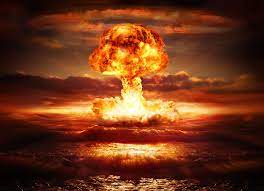The Evolution of Pakistan and India Nuclear powers
Title: The Evolution of Pakistan and India as Nuclear Powers: A Comprehensive Analysis
Abstract:
This essay aims to provide a comprehensive analysis of how Pakistan and India became atomic power countries. It explores the historical context, political motivations, scientific advancements, and key milestones that led to the nuclearization of these neighboring South Asian nations. The essay will delve into the factors driving their nuclear ambitions, the challenges they faced, and the implications of their nuclear programs. By examining the intricate details of Pakistan and India's journeys towards nuclear capability, this essay aims to shed light on the complex dynamics and consequences of nuclear proliferation in the region.
Table of Contents:
Introduction
Historical Context
2.1 Partition of British India
2.2 Indo-Pakistani Conflicts
2.3 Global Nuclear Landscape
Motivations for Nuclearization
3.1 Security Concerns
3.2 Deterrence Theory
3.3 Balance of Power
Scientific and Technological Developments
4.1 Indian Nuclear Program
4.1.1 Homi Bhabha and the Early Years
4.1.2 Pokhran-I: India's First Nuclear Test
4.1.3 Indira Gandhi's Leadership and the Peaceful Nuclear Explosion
4.1.4 The 1998 Pokhran-II Tests
4.2 Pakistani Nuclear Program
4.2.1 Zulfikar Ali Bhutto and the Foundations
4.2.2 Abdul Qadeer Khan and Nuclear Proliferation
4.2.3 Chagai-I: Pakistan's First Nuclear Test
4.2.4 The Response to India's Pokhran-II Tests
Regional and Global Implications
5.1 Escalation of Indo-Pakistani Rivalry
5.2 Nuclear Arms Race in South Asia
5.3 Nuclear Non-Proliferation Regime
5.4 International Reactions and Diplomatic Efforts
Challenges and Concerns
6.1 Nuclear Safety and Security
6.2 Strategic Stability
6.3 Kashmir Dispute
6.4 Terrorism and Non-State Actors
Future Perspectives
7.1 Confidence-Building Measures
7.2 Nuclear Arms Control and Disarmament
7.3 Role of International Community
Conclusion
Introduction:
The nuclearization of Pakistan and India has had a profound impact on regional and global dynamics. The acquisition of nuclear weapons by these two countries has significantly altered the security calculus in South Asia and raised concerns about stability and proliferation. Understanding the historical, political, and scientific aspects of how Pakistan and India became atomic power countries is crucial for grasping the complexities and challenges associated with nuclear programs.
Historical Context:
To comprehend the journey of nuclearization in Pakistan and India, one must consider the historical context in which these countries emerged. The partition of British India in 1947 and subsequent conflicts between Pakistan and India shaped their respective national identities and security perceptions. Additionally, the global nuclear landscape and the Cold War rivalry between the United States and the Soviet Union set the stage for nuclear proliferation.
Motivations for Nuclearization:
Several motivations drove Pakistan and India to pursue nuclear weapons. Security concerns, particularly related to the antagonistic relationship between the two countries, played a significant role. Deterrence theory and the pursuit of a balance of power also influenced their nuclear aspirations.
Scientific and Technological Developments:
The scientific and technological advancements made by Pakistan and India were pivotal in their quest for atomic power status. This section explores the key milestones and figures involved in the nuclear programs of both countries. From Homi Bhabha's contributions to India's nuclear ambitions to Abdul Qadeer Khan's role in Pakistan's nuclear development and subsequent proliferation activities, this section examines the scientific underpinnings of their nuclear programs.
Regional and Global Implications:
The nuclearization of Pakistan and India had wide-ranging implications at regional and global levels. It intensified the Indo-Pakistani rivalry, triggering an arms race in South Asia. The essay analyzes the impact of their nuclear programs on the regional security environment and the broader non-proliferation regime. Furthermore, it delves into international reactions and diplomatic efforts aimed at managing the nuclear capabilities of these countries.
Challenges and Concerns:
The acquisition of nuclear weapons by Pakistan and India brought forth various challenges and concerns. This section examines the issues related to nuclear safety and security, strategic stability, the Kashmir dispute, and the threat of terrorism and non-state actors. It highlights the risks associated with nuclear weapons in volatile regional contexts.
Future Perspectives:
Considering the complex dynamics surrounding the nuclear programs of Pakistan and India, this section explores potential future perspectives. Confidence-building measures, arms control, disarmament efforts, and the role of the international community are discussed as possible avenues for managing and mitigating risks associated with their nuclear capabilities.
Conclusion:
The nuclear journeys of Pakistan and India have had significant implications for regional and global security. This essay concludes by summarizing the historical, political, scientific, and strategic factors that contributed to their emergence as atomic power countries. It emphasizes the importance of addressing the challenges associated with nuclear proliferation and promoting stability and peace in South Asia and beyond


Comments
Post a Comment